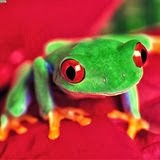Well, I did say there was going to be something about an Irish monk...
View Larger Map
Ok, so it's about the 8th century A.D., and the scene is Reichenau Island,1 in the very very South of what is now Germany, as seen on the map above. Specifically, we are looking at the Benedictine Abbey of Reichenau, founded in A.D. 724 by St. Pirmin, who may have been a Visigoth although that's beside the point. The Abbey of Reichenau is believed (to this day!) to contain the jug used at the Wedding at Cana, although that too is irrelevant to our purpose.
No, our interest today is drawn to the abbey's scriptorium, wherein we shall find a possibly bored monk.2 He is busy working on a document that will become known as the Reichenauer Schulheft (Stift St. Paul Cod. 86a/1), which translates as the Reichenauer Primer. The Primer contains a general miscellany of writings, mostly in Latin, but including some Greek and bits of Old High German. It was probably intended purely as scribing practice, which may explain why the monk is bored. Here's a sample page:
 One folio of the Reichenauer Schulheft. The chart on the right-hand side appears to be astronomical in nature, to judge from the constellation names. Click to see larger version.
One folio of the Reichenauer Schulheft. The chart on the right-hand side appears to be astronomical in nature, to judge from the constellation names. Click to see larger version.And how do we know/suspect that the monk is finding this day's work a bit tedious? Well, we know because he has become distracted by the antics of his little scriptorium cell's other denizen. The end result of this distraction is a short poem, jotted down in the Primer in Old Irish, which we may safely assume is the monk's mother tongue. The poem is at the bottom of the left-hand page in the above picture, but here it is, in its original language, so that you don't have to squint:
cechtar nathar fria saindan:
bíth a menmasam fri seilgg,
mu memna céin im saincheirdd.
Caraimse fos (ferr cach clu)
oc mu lebran, leir ingnu;
ni foirmtech frimm Pangur Bán:
caraid cesin a maccdán.
O ru biam (scél cen scís)
innar tegdais, ar n-oendís,
taithiunn, dichrichide clius,
ni fris tarddam ar n-áthius.
Gnáth, huaraib, ar gressaib gal
glenaid luch inna línsam;
os mé, du-fuit im lín chéin
dliged ndoraid cu ndronchéill.
Fuachaidsem fri frega fál
a rosc, a nglése comlán;
fuachimm chein fri fegi fis
mu rosc reil, cesu imdis.
Faelidsem cu ndene dul
hi nglen luch inna gerchrub;
hi tucu cheist ndoraid ndil
os me chene am faelid.
Cia beimmi a-min nach ré
ni derban cách a chele:
maith la cechtar nár a dán;
subaigthius a óenurán.
He fesin as choimsid dáu
in muid du-ngni cach oenláu;
du thabairt doraid du glé
for mu mud cein am messe.
Now, I confess that my knowledge of Old Irish is practically non-existent. I know that "bán" means "white," or "pale," or, in modern Irish, "blonde," and I can hazard a guess that "lebran," in the second verse, means "book," on account of us dealing with an Indo-European language. I've got some vague notions about a coupld of other words in the poem, but that's about as far as I can go, so I will step aside, and hand things over to a translation by J. Marchand (found here, with some other translations). Of all the translations of the poem that I've seen, I prefer this one, as I get the sense that it sticks quite closely to the original language.
1. I and White Pangur, each of us in his special craft. His mind is set on hunting; my mind is on my special subject.
2. I love resting (better than any fame) at my book, with diligent understanding; White Pangur is not envious of me; he loves his childish craft.
3. When we are (tale without tiredness), in our house, being alone, we have an endless sport, a thing to which we may apply our skill.
4. It is usual, at times, by feats of valor, that a mouse sticks in his net. As for me, there falls into my net, a difficult rule with hard meaning.
5. He points fiercely against an enclosing wall his eye, bright, perfect. I myself direct against the keenness of knowledge my sharp eye, though it be quite weak.
6. He is happy with swiftness of movement upon a mouse sticking in his sharp paws. Which I understand a difficult pleasant problem, as for me, I am happy, too.
7. Though we may be indeed (like this) at any time, neither disturbs his partner; good to each of us is his art, each rejoices in them.
8. He himself is master of it, the work which he does every day. To bring clarity to difficulty, I am at my own work.
A more poetic translation may be found here. Anyway, there we have it. A monk at work in a scriptorium took a brain-break, and because of that, 1250 or so years later, we know of the existence (and name!) of a particular white cat. Neat, hmmm?
1At least, it's probably Reichenau Island, or at least somewhere in the vicinity.
2It is just possible that this monk is Sedulius Scottus, but we don't know for sure.





4 comments:
but how beautiful!
I am in the HoJo in Yorkton, in the LAST hotel room in Yorkton, also A SMOKING hotel room in Yorkton, hack=kaff. But it was the last one. Moral: stop when well off, ie in Saskatoon.
checking in again tomorrow, possibly from Kenora.
It is quite a nice piece, isn't it!
Glad to hear that you got to Yorkton, and I trust that the driving conditions have been good! Sorry about the smoking room... Happy driving today!
in Kenora, nicer room, reserved it in advance, ha ha. NOT getting my emails, so pls. communicate via FB or comments on the blog.
Today's driving went better, 100 km fewer, started 4 hours earlier, took fairly frequent breaks, ate, walked, etc. Short drive tomorrow and the following days. Comparatively!
Sounds good - glad to hear you're safely in Kenora! Seen any wildlife?
Post a Comment